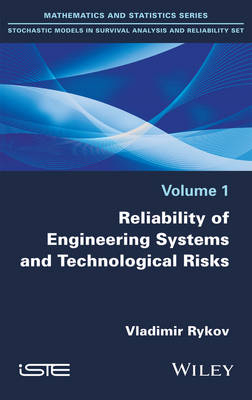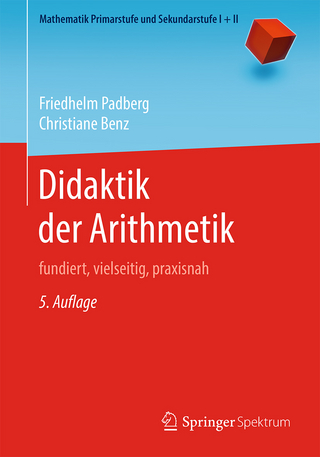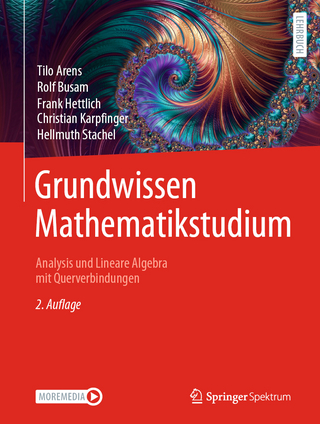
Reliability of Engineering Systems and Technological Risk
ISTE Ltd and John Wiley & Sons Inc (Verlag)
978-1-78630-001-0 (ISBN)
Although the material in this book is aimed at those working towards a bachelor's degree in engineering, it may also be of interest to postgraduate students and specialists dealing with problems related to reliability and risks.
Vladimir Rykov is Professor in the Applied Mathematics and Computer Modeling Department of the Gubkin Russian State Oil and Gas University in Moscow. His main interests include controllable queueing systems and reliability theory.
Preface ix
Notations and Abbreviations xi
Chapter 1. Reliability of Engineering Systems 1
1.1. Basic notions and characteristics of reliability 1
1.1.1. Basic notions 1
1.1.2. Reliability of non-renewable units 3
1.1.3. Some parametric families of continuous distributions of non-negative random variables 7
1.1.4. Examples 21
1.1.5. Exercises 23
1.2. Reliability of renewable systems 24
1.2.1. Reliability of instantaneously renewable articles 24
1.2.2. Renewal function 30
1.2.3. Age and residual lifetime of an article 34
1.2.4. Reliability characteristics with regard to replacement time 37
1.2.5. Examples 38
1.2.6. Exercises 43
1.3. Statistical analysis of reliability characteristics 44
1.3.1. Introductory notes 44
1.3.2. Observations and the plans of reliability trials 45
1.3.3. Statistical analysis of reliability characteristics for trials under the basic plan 46
1.3.4. Statistical estimation of the reliability characteristics and indexes for trials with renewable units 50
1.3.5. Examples 52
1.3.6. Exercises 54
1.4. Structural reliability 54
1.4.1. System structure function 55
1.4.2. Monotone structures 57
1.4.3. Reliability of monotone systems from independent elements 61
1.4.4. Reliability function for monotone structures 63
1.4.5. Exercises 64
1.5. System life tree and its structure function 68
1.5.1. Event tree 68
1.5.2. An object structure scheme 69
1.5.3. An example: the auto engine structure scheme 71
1.5.4. Life tree and the system structure function 72
1.5.5. Calculation of the system reliability 76
1.5.6. System reliability function calculation 79
1.6. Non-renewable redundant systems 82
1.6.1. Basic redundancy means – terms 82
1.6.2. Hot redundancy 84
1.6.3. Cold redundancy 85
1.6.4. Markov process for system reliability investigations 86
1.6.5. Reliability properties of redundant systems 90
1.6.6. A unit warranty operating time calculation 95
1.6.7. Exercises 96
1.7. Renewable redundant systems 97
1.7.1. The model 97
1.7.2. Equations for probabilities of the system states 99
1.7.3. Steady state probabilities: system failure probability 100
1.7.4. Reliability function for renewable systems 101
1.7.5. Exercises 105
1.8. Bibliographical comments 108
1.8.1. Section 1.1 108
1.8.2. Section 1.2 108
1.8.3. Section 1.3 108
1.8.4. Section 1.4 108
1.8.5. Section 1.5 109
1.8.6. Sections 1.6 and 1.7 109
Chapter 2. Reliability and Risk 111
2.1. Risk: notion and measurement 111
2.1.1. Introductory notes 111
2.1.2. Examples 112
2.1.3. Risk notion 114
2.1.4. Risk measurement 115
2.1.5. Risk modeling 118
2.1.6. Exercises 120
2.2. Models of damage value 120
2.2.1. Introductory remarks 120
2.2.2. Simple damage models 121
2.2.3. Compound damages. Methods of investigation 125
2.2.4. Moments of compound damages 130
2.2.5. Models of compound damages 132
2.2.6. Examples 136
2.2.7. Exercises 137
2.3. Methods of risk analysis 137
2.3.1. Introductory remarks 137
2.3.2. Methodology of risk analysis 138
2.3.3. Risk tree construction 139
2.3.4. Risk tree rigging 143
2.3.5. Risk tree analysis 144
2.3.6. Exercise 157
2.4. Bibliographical comments 158
2.4.1. Section 2.1 158
2.4.2. Section 2.2 158
2.4.3. Section 2.3 158
Chapter 3. Risk Management 159
3.1. Insurance of risks and risk of insurance 159
3.1.1. Introductory remarks 159
3.1.2. Basic notions 159
3.1.3. Risk insurance models 161
3.1.4. Basic risk insurance problems 162
3.1.5. Examples 163
3.1.6. Exercises 167
3.2. Some notions and methods of financial mathematics 168
3.2.1. Principal notion of financial mathematics 168
3.2.2. Simple interests 170
3.2.3. Compound interests 172
3.2.4. Cash flows and the financial rents 174
3.2.5. Exercises 177
3.3. Short-time insurance model investigation 179
3.3.1. Introductory remarks 179
3.3.2. Calculation of the individual claim indexes 180
3.3.3. Exact calculation of summary claim characteristics 182
3.3.4. Normal asymptotic of summary claim distribution 183
3.3.5. Poisson asymptotic of summary claim distribution 184
3.3.6. Calculation of insurance basic characteristics 185
3.3.7. Exercises 187
3.4. Long-time insurance model investigation 188
3.4.1. Introductory remarks 188
3.4.2. The basic parameters of long-time insurance contracts 189
3.4.3. Insurance annuity analysis 190
3.4.4. The net-premium calculation 192
3.4.5. Insurance load calculation 193
3.4.6. An example 195
3.4.7. Exercises 198
3.5. Bibliographical comments 198
3.5.1. Section 3.1 198
3.5.2. Section 3.2 198
3.5.3. Sections 3.3 and 3.4 198
Appendices 199
Appendix 1 201
Appendix 2 203
Bibliography 207
Index 209
| Erscheinungsdatum | 25.08.2016 |
|---|---|
| Verlagsort | London |
| Sprache | englisch |
| Maße | 165 x 241 mm |
| Gewicht | 494 g |
| Themenwelt | Mathematik / Informatik ► Mathematik |
| Technik ► Maschinenbau | |
| ISBN-10 | 1-78630-001-X / 178630001X |
| ISBN-13 | 978-1-78630-001-0 / 9781786300010 |
| Zustand | Neuware |
| Haben Sie eine Frage zum Produkt? |
aus dem Bereich


